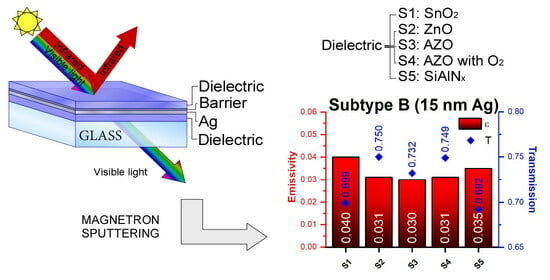Comparison of the Optical Properties of Different Dielectric Materials (SnO2, ZnO, AZO, or SiAlNx) Used in Silver-Based Low-Emissivity Coatings
Abstract
:1. Introduction
2. Experiment
2.1. Preparation of Low-e Multilayer Films
2.2. Characterization
3. Results and Discussion
3.1. Emissivity
3.2. Optical Properties
4. Conclusions
Supplementary Materials
Author Contributions
Funding
Institutional Review Board Statement
Informed Consent Statement
Data Availability Statement
Acknowledgments
Conflicts of Interest
References
- Jelle, B.P.; Hynd, A.; Gustavsen, A.; Arasteh, D.; Goudey, H.; Hart, R. Fenestration of Today and Tomorrow: A State-of-the-Art Review and Future Research Opportunities. Sol. Energy Mater. Sol. Cells 2012, 96, 1–28. [Google Scholar] [CrossRef]
- Cuce, E.; Cuce, P.M. Vacuum Glazing for Highly Insulating Windows: Recent Developments and Future Prospects. Renew. Sustain. Energy Rev. 2016, 54, 1345–1357. [Google Scholar] [CrossRef]
- Arbab, M.; Finley, J.J. Glass in Architecture. Int. J. Appl. Glass Sci. 2010, 1, 118–129. [Google Scholar] [CrossRef]
- Schaefer, C.; Bräuer, G.; Szczyrbowski, J. Low Emissivity Coatings on Architectural Glass. Surf. Coat. Technol. 1997, 93, 37–45. [Google Scholar] [CrossRef]
- Arbab, M. Sputter-Deposited Low-Emissivity Coatings on Glass. MRS Bull. 1997, 22, 27–35. [Google Scholar] [CrossRef]
- Jelle, B.P.; Kalnæs, S.E.; Gao, T. Low-Emissivity Materials for Building Applications: A State-of-the-Art Review and Future Research Perspectives. Energy Build. 2015, 96, 329–356. [Google Scholar] [CrossRef]
- Gorgolis, G.; Karamanis, D. Solar Energy Materials for Glazing Technologies. Sol. Energy Mater. Sol. Cells 2016, 144, 559–578. [Google Scholar] [CrossRef]
- Mohelnikova, J. Materials for Reflective Coatings of Window Glass Applications. Constr. Build. Mater. 2009, 23, 1993–1998. [Google Scholar] [CrossRef]
- Pracchia, J.A.; Simon, J.M. Transparent Heat Mirrors: Influence of the Materials on the Optical Characteristics. Appl. Opt. 1981, 20, 251–258. [Google Scholar] [CrossRef]
- Dalapati, G.K.; Kushwaha, A.K.; Sharma, M.; Suresh, V.; Shannigrahi, S.; Zhuk, S.; Masudy-Panah, S. Transparent Heat Regulating (THR) Materials and Coatings for Energy Saving Window Applications: Impact of Materials Design, Micro-Structural, and Interface Quality on the THR Performance. Prog. Mater. Sci. 2018, 95, 42–131. [Google Scholar] [CrossRef]
- Alvarez, R.; González, J.C.; Espinós, J.P.; González-Elipe, A.R.; Cueva, A.; Villuendas, F. Growth of Silver on ZnO and SnO2 Thin Films Intended for Low Emissivity Applications. Appl. Surf. Sci. 2013, 268, 507–515. [Google Scholar] [CrossRef]
- Kulczyk-Malecka, J.; Kelly, P.J.; West, G.; Clarke, G.C.B.; Ridealgh, J.A. Investigations of Diffusion Behaviour in Al-Doped Zinc Oxide and Zinc Stannate Coatings. Thin Solid Film. 2011, 520, 1368–1374. [Google Scholar] [CrossRef]
- Kulczyk-Malecka, J.; Kelly, P.J.; West, G.; Clarke, G.C.B.; Ridealgh, J.A.; Almtoft, K.P.; Greer, A.L.; Barber, Z.H. Investigation of Silver Diffusion in TiO2/Ag/TiO2 Coatings. Acta Mater. 2014, 66, 396–404. [Google Scholar] [CrossRef]
- Gläser, H.J. History of the Development and Industrial Production of Low Thermal Emissivity Coatings for High Heat Insulating Glass Units. Appl. Opt. 2008, 47, C193–C199. [Google Scholar] [CrossRef]
- Safi, I. Recent Aspects Concerning DC Reactive Magnetron Sputtering of Thin Films: A Review. Surf. Coat. Technol. 2000, 127, 203–218. [Google Scholar] [CrossRef]
- Beister, G.; Dietrich, E.; Schaefer, C.; Scherer, M.; Szczyrbowski, J. Progress in Large-Area Glass Coatings by High-Rate Sputtering. Surf. Coat. Technol. 1995, 76–77, 776–785. [Google Scholar] [CrossRef]
- Berg, S.; Nyberg, T. Fundamental Understanding and Modeling of Reactive Sputtering Processes. Thin Solid Film. 2005, 476, 215–230. [Google Scholar] [CrossRef]
- Khaled, K.; Berardi, U. Current and Future Coating Technologies for Architectural Glazing Applications. Energy Build. 2021, 244, 111022. [Google Scholar] [CrossRef]
- Tsai, D.-C.; Chang, Z.-C.; Kuo, B.-H.; Chen, E.-C.; Huang, Y.-L.; Hsieh, T.-J.; Shieu, F.-S. Thermal Stability and Optical Properties of Low Emissivity Multilayer Coatings for Energy-Saving Applications. Ceram. Int. 2020, 46, 7991–7997. [Google Scholar] [CrossRef]
- Meszaros, R.; Merle, B.; Wild, M.; Durst, K.; Göken, M.; Wondraczek, L. Effect of Thermal Annealing on the Mechanical Properties of Low-Emissivity Physical Vapor Deposited Multilayer-Coatings for Architectural Applications. Thin Solid Film. 2012, 520, 7130–7135. [Google Scholar] [CrossRef]
- Lai, C.-C.; Goyenola, C.; Broitman, E.; Näslund, L.-Å.; Högberg, H.; Hultman, L.; Gueorguiev, G.K.; Rosen, J. Synthesis and Properties of CSxFy Thin Films Deposited by Reactive Magnetron Sputtering in an Ar/SF6 Discharge. J. Phys. Condens. Matter 2017, 29, 195701. [Google Scholar] [CrossRef] [PubMed]
- Oliveira, M.J.T.; Medeiros, P.V.C.; Sousa, J.R.F.; Nogueira, F.; Gueorguiev, G.K. Optical and Magnetic Excitations of Metal-Encapsulating Si Cages: A Systematic Study by Time-Dependent Density Functional Theory. J. Phys. Chem. C 2014, 118, 11377–11384. [Google Scholar] [CrossRef]
- Oprea, C.I.; Panait, P.; Cimpoesu, F.; Ferbinteanu, M.; Gîrţu, M.A. Density Functional Theory (DFT) Study of Coumarin-Based Dyes Adsorbed on TiO2 Nanoclusters—Applications to Dye-Sensitized Solar Cells. Materials 2013, 6, 2372–2392. [Google Scholar] [CrossRef] [PubMed]
- Crystals |Free Full-Text| Influence of Au, Ag, and Cu Adatoms on Optical Properties of TiO2 (110) Surface: Predictions from RT-TDDFT Calculations. Available online: https://www.mdpi.com/2073-4352/12/4/452 (accessed on 21 August 2023).
- Grosse, P.; Hertling, R.; Müggenburg, T. Design of Low Emissivity Systems Based on a Three-Layer Coating. J. Non-Cryst. Solids 1997, 218, 38–43. [Google Scholar] [CrossRef]
- Sahu, D.R.; Huang, J.-L. Characteristics of ZnO–Cu–ZnO Multilayer Films on Copper Layer Properties. Appl. Surf. Sci. 2006, 253, 827–832. [Google Scholar] [CrossRef]
- Song, S.; Yang, T.; Lv, M.; Li, Y.; Xin, Y.; Jiang, L.; Wu, Z.; Han, S. Effect of Cu Layer Thickness on the Structural, Optical and Electrical Properties of AZO/Cu/AZO Tri-Layer Films. Vacuum 2010, 85, 39–44. [Google Scholar] [CrossRef]
- Wang, Y.P.; Lu, J.G.; Bie, X.; Ye, Z.Z.; Li, X.; Song, D.; Zhao, X.Y.; Ye, W.Y. Transparent Conductive and Near-Infrared Reflective Cu-Based Al-Doped ZnO Multilayer Films Grown by Magnetron Sputtering at Room Temperature. Appl. Surf. Sci. 2011, 257, 5966–5971. [Google Scholar] [CrossRef]
- Chiu, P.-K.; Liou, B.-H.; Hsiao, C.-N.; Yang, J.-R.; Chiang, D.; Cho, W.-H.; Lee, C.-T. Investigation on Optical and Electrical Properties of ZnO Sandwich Structure with Metal Interlayer. Jpn. J. Appl. Phys. 2014, 53, 05FF05. [Google Scholar] [CrossRef]
- Sun, K.; Zhang, D.; Yin, H.; Cheng, L.; Yuan, H.; Yang, C. Preparation of AZO/Cu/AZO Films with Low Infrared Emissivity, High Conductivity and High Transmittance by Adjusting the AZO Layer. Appl. Surf. Sci. 2022, 578, 152051. [Google Scholar] [CrossRef]
- Ding, G.; Clavero, C. Silver-Based Low-Emissivity Coating Technology for Energy-Saving Window Applications; IntechOpen: London, UK, 2017; ISBN 978-953-51-3004-8. [Google Scholar]
- Martίn-Palma, R.J.; Vázquez, L.; Martίnez-Duart, J.M. Malats-Riera Silver-Based Low-Emissivity Coatings for Architectural Windows: Optical and Structural Properties. Sol. Energy Mater. Sol. Cells 1998, 53, 55–66. [Google Scholar] [CrossRef]
- Rabizadeh, M.; Ehsani, M.H.; Shahidi, M.M. Tuning the Optical Properties of SnO2/Ag/SnO2 Tri-Layers by Changing Ag Thickness. Infrared Phys. Technol. 2020, 109, 103421. [Google Scholar] [CrossRef]
- Sahu, D.R.; Lin, S.-Y.; Huang, J.-L. ZnO/Ag/ZnO Multilayer Films for the Application of a Very Low Resistance Transparent Electrode. Appl. Surf. Sci. 2006, 252, 7509–7514. [Google Scholar] [CrossRef]
- Sahu, D.R.; Huang, J.-L. High Quality Transparent Conductive ZnO/Ag/ZnO Multilayer Films Deposited at Room Temperature. Thin Solid Film. 2006, 515, 876–879. [Google Scholar] [CrossRef]
- Mohamed, S.H. Effects of Ag Layer and ZnO Top Layer Thicknesses on the Physical Properties of ZnO/Ag/Zno Multilayer System. J. Phys. Chem. Solids 2008, 69, 2378–2384. [Google Scholar] [CrossRef]
- Yu, X.; Zhang, D.; Wang, P.; Murakami, R.-I.; Ding, B.; Song, X. The Optical and Electrical Properties of ZnO/Ag/ZnO Films on Flexible Substrate. Int. J. Mod. Phys. Conf. Ser. 2012, 06, 557–562. [Google Scholar] [CrossRef]
- Nezhad, E.H.; Haratizadeh, H.; Kari, B.M. Influence of Ag Mid-Layer in the Optical and Thermal Properties of ZnO/Ag/ZnO Thin Films on the Glass Used in Buildings as Insulating Glass Unit (IGU). Ceram. Int. 2019, 45, 9950–9954. [Google Scholar] [CrossRef]
- Wu, H.-W.; Yang, R.-Y.; Hsiung, C.-M.; Chu, C.-H. Influence of Ag Thickness of Aluminum-Doped ZnO/Ag/Aluminum-Doped ZnO Thin Films. Thin Solid Film. 2012, 520, 7147–7152. [Google Scholar] [CrossRef]
- Miao, D.; Jiang, S.; Zhao, H.; Shang, S.; Chen, Z. Characterization of AZO and Ag Based Films Prepared by RF Magnetron Sputtering. J. Alloys Compd. 2014, 616, 26–31. [Google Scholar] [CrossRef]
- Miao, D.; Jiang, S.; Shang, S.; Chen, Z. Infrared Reflective Properties of AZO/Ag/AZO Trilayers Prepared by RF Magnetron Sputtering. Ceram. Int. 2014, 40, 12847–12853. [Google Scholar] [CrossRef]
- Ho Kim, J.; Moon, Y.-J.; Kim, S.-K.; Yoo, Y.-Z.; Seong, T.-Y. Al-Doped ZnO/Ag/Al-Doped ZnO Multilayer Films with a High Figure of Merit. Ceram. Int. 2015, 41, 14805–14810. [Google Scholar] [CrossRef]
- Sun, K.; Tang, X.; Yang, C.; Jin, D. Preparation and Performance of Low-Emissivity Al-Doped ZnO Films for Energy-Saving Glass. Ceram. Int. 2018, 44, 19597–19602. [Google Scholar] [CrossRef]
- Cinali, M.B.; Coşkun, Ö.D. Optimization of Physical Properties of Sputtered Silver Films by Change of Deposition Power for Low Emissivity Applications. J. Alloys Compd. 2021, 853, 157073. [Google Scholar] [CrossRef]
- Choi, K.H.; Kim, J.Y.; Lee, Y.S.; Kim, H.J. ITO/Ag/ITO Multilayer Films for the Application of a Very Low Resistance Transparent Electrode. Thin Solid Film. 1999, 341, 152–155. [Google Scholar] [CrossRef]
- Klöppel, A.; Kriegseis, W.; Meyer, B.K.; Scharmann, A.; Daube, C.; Stollenwerk, J.; Trube, J. Dependence of the Electrical and Optical Behaviour of ITO–Silver–ITO Multilayers on the Silver Properties. Thin Solid Film. 2000, 365, 139–146. [Google Scholar] [CrossRef]
- Leftheriotis, G.; Yianoulis, P. Characterisation and Stability of Low-Emittance Multiple Coatings for Glazing Applications. Sol. Energy Mater. Sol. Cells 1999, 58, 185–197. [Google Scholar] [CrossRef]
- Liu, X.; Cai, X.; Qiao, J.; Mao, J.; Jiang, N. The Design of ZnS/Ag/ZnS Transparent Conductive Multilayer Films. Thin Solid Film. 2003, 441, 200–206. [Google Scholar] [CrossRef]
- Yuste, M.; Galindo, R.E.; Sánchez, O.; Cano, D.; Casasola, R.; Albella, J.M. Correlation between Structure and Optical Properties in Low Emissivity Coatings for Solar Thermal Collectors. Thin Solid Film. 2010, 518, 5720–5723. [Google Scholar] [CrossRef]
- Yuste, M.; Galindo, R.E.; Carvalho, S.; Albella, J.M.; Sánchez, O. Improving the Visible Transmittance of Low-e Titanium Nitride Based Coatings for Solar Thermal Applications. Appl. Surf. Sci. 2011, 258, 1784–1788. [Google Scholar] [CrossRef]
- Kim, J.H.; Lee, H.-K.; Na, J.-Y.; Kim, S.-K.; Yoo, Y.-Z.; Seong, T.-Y. Dependence of Optical and Electrical Properties on Ag Thickness in TiO2/Ag/TiO2 Multilayer Films for Photovoltaic Devices. Ceram. Int. 2015, 41, 8059–8063. [Google Scholar] [CrossRef]
- Huang, J.; Xiang, C.; Li, S.; Zhao, X.; He, G. Preparation, Characterization and Performance of Ti1−xAlxN/Ag/Ti1−xAlxN Low-Emissivity Films. Appl. Surf. Sci. 2014, 293, 259–264. [Google Scholar] [CrossRef]
- Ferrara, M.; Castaldo, A.; Esposito, S.; D’Angelo, A.; Guglielmo, A.; Antonaia, A. AlN–Ag Based Low-Emission Sputtered Coatings for High Visible Transmittance Window. Surf. Coat. Technol. 2016, 295, 2–7. [Google Scholar] [CrossRef]
- Xu, K.; Du, M.; Hao, L.; Mi, J.; Lin, Y.; Li, S.; Wang, J.; Deng, X. Optical Optimization and Thermal Stability of SiN/Ag/SiN Based Transparent Heat Reflecting Coatings. Infrared Phys. Technol. 2022, 122, 104089. [Google Scholar] [CrossRef]
- Ando, E.; Miyazaki, M. Moisture Resistance of the Low-Emissivity Coatings with a Layer Structure of Al-Doped ZnO/Ag/Al-Doped ZnO. Thin Solid Film. 2001, 392, 289–293. [Google Scholar] [CrossRef]
- Suchea, M.; Christoulakis, S.; Katsarakis, N.; Kitsopoulos, T.; Kiriakidis, G. Comparative Study of Zinc Oxide and Aluminum Doped Zinc Oxide Transparent Thin Films Grown by Direct Current Magnetron Sputtering. Thin Solid Film. 2007, 515, 6562–6566. [Google Scholar] [CrossRef]
- Girtan, M. Comparison of ITO/Metal/ITO and ZnO/Metal/ZnO Characteristics as Transparent Electrodes for Third Generation Solar Cells. Sol. Energy Mater. Sol. Cells 2012, 100, 153–161. [Google Scholar] [CrossRef]
- Niu, Y.; Ma, X.; Liu, X.; Wang, W.; Zhen, Y.; Gao, Y. Spreadability of Ag Layer on Oxides and High Performance of AZO/Ag/AZO Sandwiched Transparent Conductive Film. J. Nanosci. 2017, 2017, 1–9. [Google Scholar] [CrossRef]
- Barman, B.; Swami, S.K.; Dutta, V. Fabrication of Highly Conducting ZnO/Ag/ZnO and AZO/Ag/AZO Transparent Conducting Oxide Layers Using RF Magnetron Sputtering at Room Temperature. Mater. Sci. Semicond. Process. 2021, 129, 105801. [Google Scholar] [CrossRef]
- Carretero, E.; Cueva, A.; Preciado-Garbayo, J.; Sevillano, P. Improved Photoenergy Properties of Low-Emissivity Coatings Deposited by Sputtering with an Ion Gun Treatment. Vacuum 2022, 205, 111485. [Google Scholar] [CrossRef]
- Bellido-Gonzalez, V.; Marco, J.M.; Sorzabal-Bellido, I.; Alonso, R.; Cueva, A. Effects of Ion Bombardment Pretreatment on Glass Coating Processes and Post Tempering. In Proceedings of the Society of Vacuum Coaters Annual Technical Conference, Indianapolis, IN, USA, 29 February 2016; pp. 177–181. [Google Scholar]
- Glass in Building Determination of Luminous and Solar Characteristics of Glazing. Available online: https://www.en-standard.eu/din-en-410-glass-in-building-determination-of-luminous-and-solar-characteristics-of-glazing/ (accessed on 21 August 2023).
- Hans, J. Gläser Large Area Glass Coating; Von Ardenne Anlagentechnik GMBH: Dresden, Germany, 2000; ISBN 3-00-004953-3. [Google Scholar]
- Guillén, C.; Herrero, J. TCO/Metal/TCO Structures for Energy and Flexible Electronics. Thin Solid Film. 2011, 520, 1–17. [Google Scholar] [CrossRef]
- Guillén, C.; Herrero, J. Transparent Electrodes Based on Metal and Metal Oxide Stacked Layers Grown at Room Temperature on Polymer Substrate. Phys. Status Solidi A 2010, 207, 1563–1567. [Google Scholar] [CrossRef]
- Mizukoshi, K.; Yamamura, T.; Tomioka, Y.; Kawamura, M. Effect of Blocking Layer on Achieving Low Sheet Resistances in Low-E Multilayer Structures. Jpn. J. Appl. Phys. 2023, 62, 045501. [Google Scholar] [CrossRef]
- Lu, L.; Luo, F.; Huang, Z.; Zhou, W.; Zhu, D. Research on Optical Reflectance and Infrared Emissivity of TiNx Films Depending on Sputtering Pressure. Infrared Phys. Technol. 2018, 91, 63–67. [Google Scholar] [CrossRef]
- Bond, W.L. Measurement of the Refractive Indices of Several Crystals. J. Appl. Phys. 2004, 36, 1674. [Google Scholar] [CrossRef]
- Philipp, H.R. Optical Properties of Silicon Nitride. J. Electrochem. Soc. 1973, 120, 295. [Google Scholar] [CrossRef]
- Şenay, V. Some Physical Properties of Nanostructured Al Doped ZnO Thin Films Synthesized by RF Magnetron Sputtering at Room Temperature. J. Mater. Sci. Mater. Electron. 2019, 30, 9910–9915. [Google Scholar] [CrossRef]
- Baco, S.; Chik, A.; Yassin, F.M. Study on Optical Properties of Tin Oxide Thin Film at Different Annealing Temperature. J. Sci. Technol. 2012, 4, 61–72. [Google Scholar]
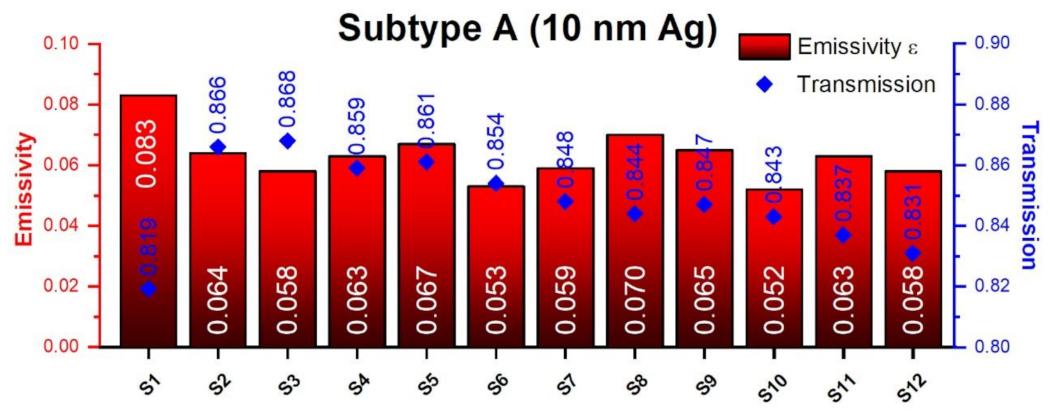


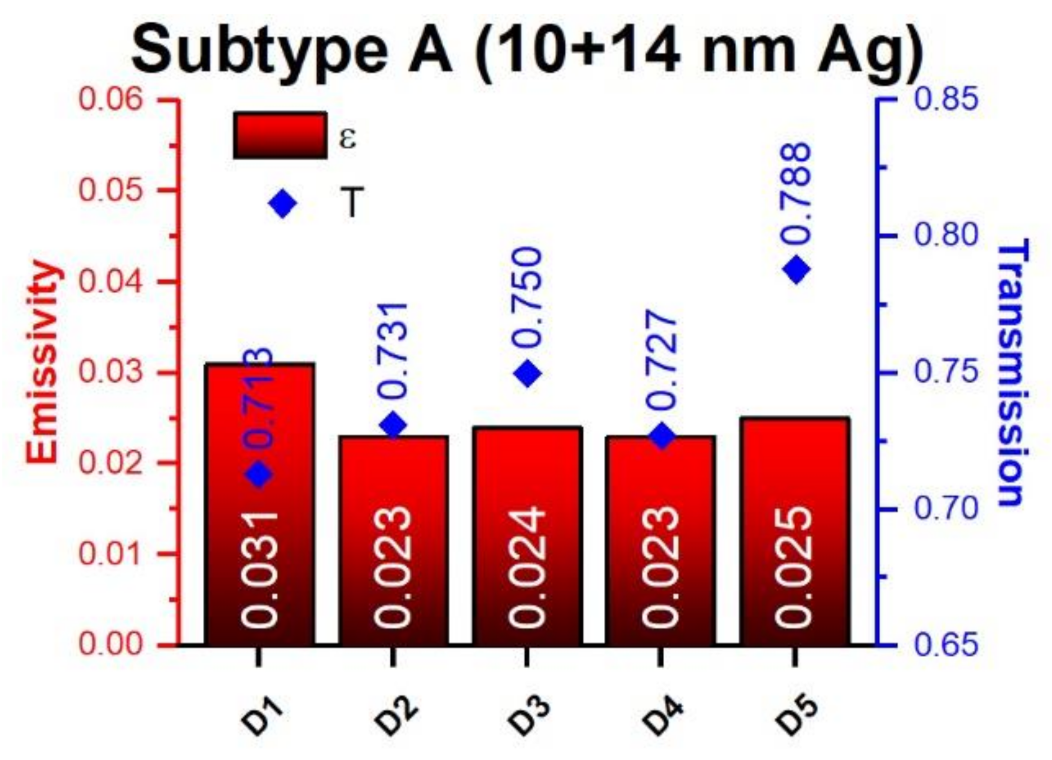
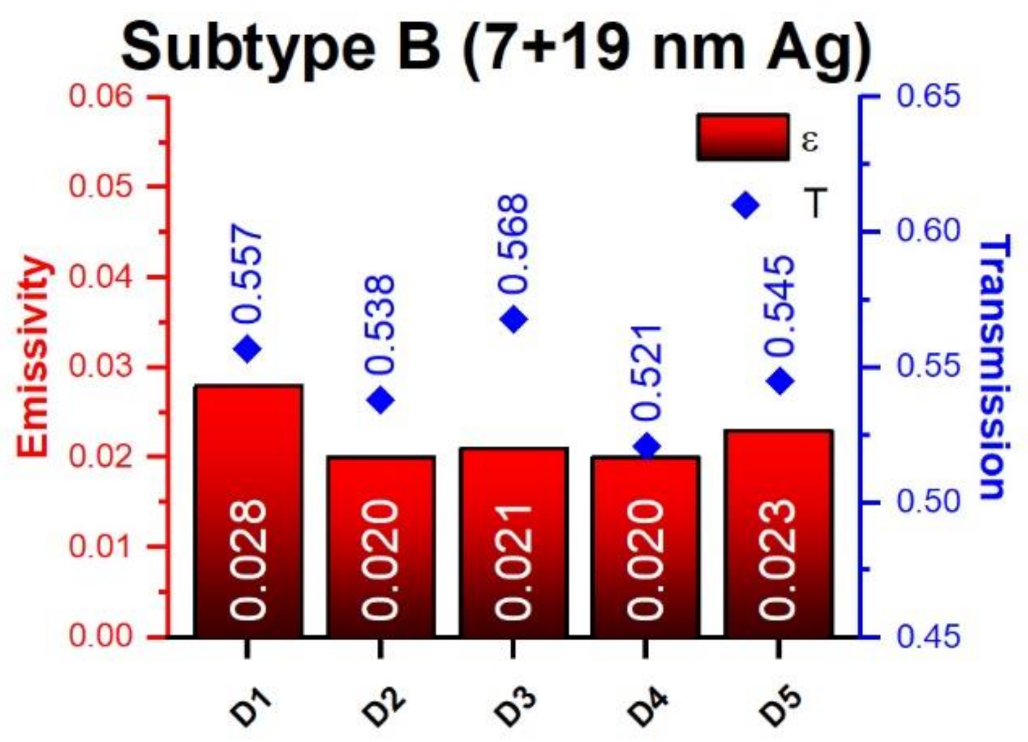

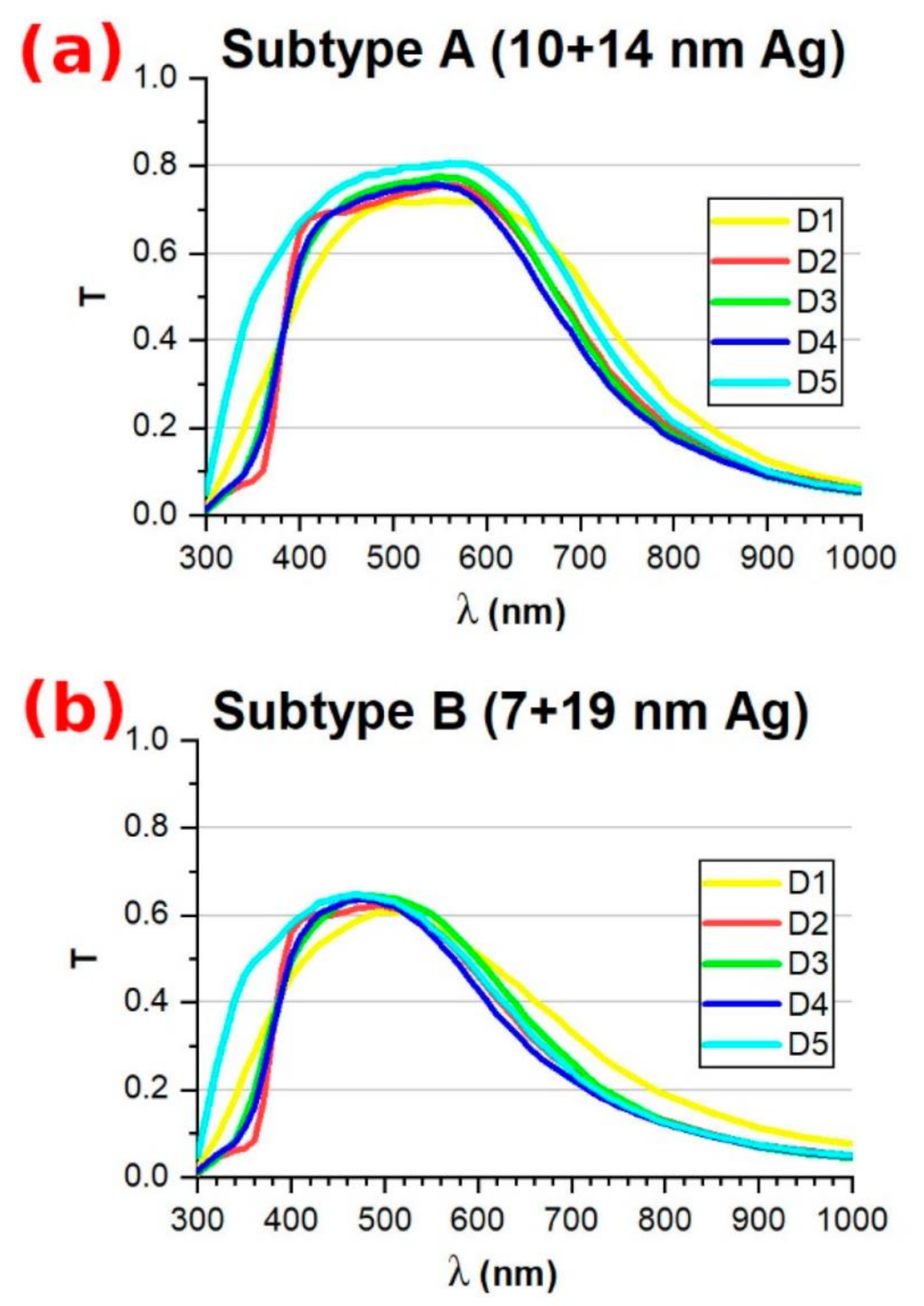
| Material | Target Purity (%) | % Weight | Power (W) | Power Density (W/cm2) | Ar Flow (sccm) | O2 Flow (sccm) | N2 Flow (sccm) |
|---|---|---|---|---|---|---|---|
| SnO2 | 99.99 | 100 | 2000 | 3.33 | 150 | 180 | 0 |
| ZnO | 99.99 | 100 | 1500 | 2.50 | 250 | 120 | 0 |
| AZO | 99.95 | Zn 98-Al 2 | 2000 | 3.33 | 300 | 0 | 0 |
| AZO_2 | 99.95 | Zn 98-Al 2 | 2000 | 3.33 | 270 | 30 | 0 |
| SiAlNx | 99.99 | Si 90-Al 10 | 2500 | 3.33 | 100 | 0 | 100 |
| Ag | 99.99 | 100 | 500 | 0.83 | 300 | 0 | 0 |
| Ti | 99.94 | 100 | 400 | 0.66 | 200 | 0 | 0 |
| Ion gun | --- | --- | 2 KV | --- | 50 | 0 | 0 |
| Sample Type | Structure | Thickness (nm) | ||
|---|---|---|---|---|
| A (10 nm Ag) | B (15 nm Ag) | C (21 nm Ag) | ||
| S1 | Glass/SnO2/Ag/Ti/SnO2 | 29/10/2/45 | 24/15/2/49 | 33/21/2/55 |
| S2 | Glass/ZnO/Ag/Ti/ZnO | 29/10/2/45 | 24/15/2/49 | 33/21/2/55 |
| S3 | Glass/AZO/Ag/Ti/AZO | 29/10/2/45 | 24/15/2/49 | 33/21/2/55 |
| S4 | Glass/AZO_2/Ag/Ti/AZO_2 | 29/10/2/45 | 24/15/2/49 | 33/21/2/55 |
| S5 | Glass/SiAlNx/Ag/Ti/SiAlNx | 29/10/2/45 | 24/15/2/49 | 33/21/2/55 |
| S6 | Glass/AZO/Ag/Ti/SiAlNx | 29/10/2/45 | 24/15/2/49 | 33/21/2/55 |
| S7 | Glass/SiAlNx/AZO/Ag/Ti/SiAlNx | 14/14/10/2/45 | 24/15/2/49 | 16/16/21/2/55 |
| S8 | Glass/AZO/SiAlNx/Ag/Ti/SiAlNx | 14/14/10/2/45 | 24/15/2/49 | 16/16/21/2/55 |
| S9 | Glass/SiAlNx/AZO/Ag/Ti/SiAlNx | 24/5/10/2/45 | 25/8/21/2/55 | |
| S10 | Glass/AZO/Ion/Ag/Ti/SiAlNx | 39/-10/10/2/45 | 43/-10/21/2/55 | |
| S11 | Glass/SiAlNx/Ion/Ag/Ti/SiAlNx | 39/-10/10/2/45 | 43/-10/21/2/55 | |
| S12 | Glass/SiAlNx/AZO/Ion/Ag/Ti/SiAlNx | 14/19/-5/10/2/45 | 16/21/-5/21/2/55 | |
| Sample Type | Structure | Thickness (nm) | |
|---|---|---|---|
| A (10 + 14 nm Ag) | B (7 + 19 nm Ag) | ||
| D1 | Glass/SnO2/Ag/Ti/SnO2/Ag/Ti/SnO2 | 29/10/2/77/14/2/34 | 30/7/2/78/19/2/32 |
| D2 | Glass/ZnO/Ag/Ti/ZnO/Ag/Ti/ZnO | 29/10/2/77/14/2/34 | 30/7/2/78/19/2/32 |
| D3 | Glass/AZO/Ag/Ti/AZO/Ag/Ti/AZO | 29/10/2/77/14/2/34 | 30/7/2/78/19/2/32 |
| D4 | Glass/AZO_2/Ag/Ti/AZO_2/Ag/Ti/AZO_2 | 29/10/2/77/14/2/34 | 30/7/2/78/19/2/32 |
| D5 | Glass/SiAlNx/Ag/Ti/SiAlNx/Ag/Ti/SiAlNx | 29/10/2/77/14/2/34 | 30/7/2/78/19/2/32 |
Disclaimer/Publisher’s Note: The statements, opinions and data contained in all publications are solely those of the individual author(s) and contributor(s) and not of MDPI and/or the editor(s). MDPI and/or the editor(s) disclaim responsibility for any injury to people or property resulting from any ideas, methods, instructions or products referred to in the content. |
© 2023 by the authors. Licensee MDPI, Basel, Switzerland. This article is an open access article distributed under the terms and conditions of the Creative Commons Attribution (CC BY) license (https://creativecommons.org/licenses/by/4.0/).
Share and Cite
Cueva, A.; Carretero, E. Comparison of the Optical Properties of Different Dielectric Materials (SnO2, ZnO, AZO, or SiAlNx) Used in Silver-Based Low-Emissivity Coatings. Coatings 2023, 13, 1709. https://doi.org/10.3390/coatings13101709
Cueva A, Carretero E. Comparison of the Optical Properties of Different Dielectric Materials (SnO2, ZnO, AZO, or SiAlNx) Used in Silver-Based Low-Emissivity Coatings. Coatings. 2023; 13(10):1709. https://doi.org/10.3390/coatings13101709
Chicago/Turabian StyleCueva, Ana, and Enrique Carretero. 2023. "Comparison of the Optical Properties of Different Dielectric Materials (SnO2, ZnO, AZO, or SiAlNx) Used in Silver-Based Low-Emissivity Coatings" Coatings 13, no. 10: 1709. https://doi.org/10.3390/coatings13101709




